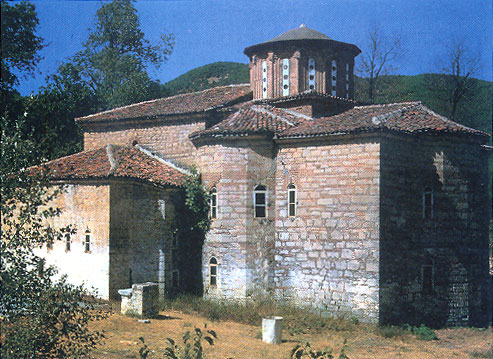
- The monastery of the rock
- Item ID : 432
- Collection Name : Holy Metropolis of Thessaliotidos and Fanariofersalon
- Category : Monastery
- Year : c. 16th AD
- Current Place : Rentina
- Description : The structure of the nave belongs to the well-known Byzantine cross-in-square type build in the cloisonne masonry. It has a tri-conch and belongs to the four columns Athonite style, with certain places for psalteries.
The four columns of which their arches that support a twelve-tall dome, divide the nave into three naves.
The two pillars of the temple and divide this space into three parts. Outside the drum of the dome is based on quadrilateral wall that is taller than the roof of the nave, while the roof of the narthex is even higher and thus lend a charm to the temple.
The splint has no domes or towers. But arches. The entrance is in the narthex, on the west side, while from the narthex to the nave, outside the main entrance to the right and left are two small doors.
A two-story building,- was build later c.1600AD, added to the west narthex, bearing frescoes and divided into two unequal areas, the northern and largest used as a "secret school".
In the south wall of the narthex and the only entrance from the narthex a chapel is annexed in honour of the Transfiguration of the Savior, which was mentioned by Ezekiel Thessaliotis. Professor Orlandos mentions two chapels. The two places for the choir of the nave and the cloisonne masonry with the above, give us the Athonite type temple with the following differences:
A. In the main church (katholikon) we have a five-sided apse, while internally we have other two, but fall into the wall and not visible from the outside. The middle conch has six windows on two levels .
B. The two choir places are pentagonal externally and internally with shallow semicircular windows on two levels, many are closed today with the wall.
C. The narthex is spacious and occupies two floors with three arches supported on two bows and arrows rely east to west with pilasters.
The two arcs later reinforced by two walls inside the vestibule with two openings each. So far the cast is divided into three parts . The second floor is downstream , extending from the narthex to the central dome and used as a " secret school " .
Also a crypt in the sanctuary above the diakonikon is considered to be secret school . The dome is a twelve-sided with many windows and a concrete roof.
The temple is carved gilded with great art . Also wood carved are the four shrines , two lecterns with ivory and a gilt carved wood representation of the apostles and prophets in the 13th icon depicting Christ .
Newer ( 1793 ) but of excellent art is the carved ciborium that are large and cover the entire altar in the nave ( m 2 , 20, pl. 1.45 m. 3 L5 ) .
In the lower eastern part of the ciborium s cabinet , houses shrines of saints .
The artists who worked in the monastery are: a) Constantine the Vrestenitsa ( Sources Assam) painted the narthex in 1789 , b ) The Lambos painted the church of the monastery in 1625 and c ) John the paltry first painted the Chapel of the Transfiguration the Saviour in 1672 . s frescoes from the 17th century and i8ou , are excellent and cover the entire temple interior, while intermediates inserted rich decoration .
The icons are of great artistic value. Typical is the mural on the west wall of the nave representing the owner Panagiotis Kouskola , holding illustration of the temple and offer it to the Virgin Mary , without inscription .
The monastery was abandoned and around 1925 the Metropolitan of Thessaliotis Ezekil, re-establish it.
There are several options regarding who the initial founder of the monastery was. Finally after extended research the results showed that the donor was Panayiotis Kouskoulas. The traditions though consider him as the founder of the monastery.
For a period the monastery was the headquarters of the G. Karaiskakis. Almost all monasteries of the Agrafa region, served as shelters and bases of operations of the freedom-fighters and thieves, in particular for large chieftains like: Bouckovalas, Katsantoni, Karaiskaki et al.
But the British traveller and Colonel Leake, who toured the region in 1809 mentions it among the five main monasteries of Agrafa region.
In Pindos, east of the man-made lake Tavropos, 4 km from the village Katafygi the Lampero (Shiny) of the municipality Itamou and in 6oo meters altitude, rises the monastery of "Petra" in memory of the Assumption.
The monastery is located 20 km from Karditsa is located in a forest between the ridges of Itamos.


